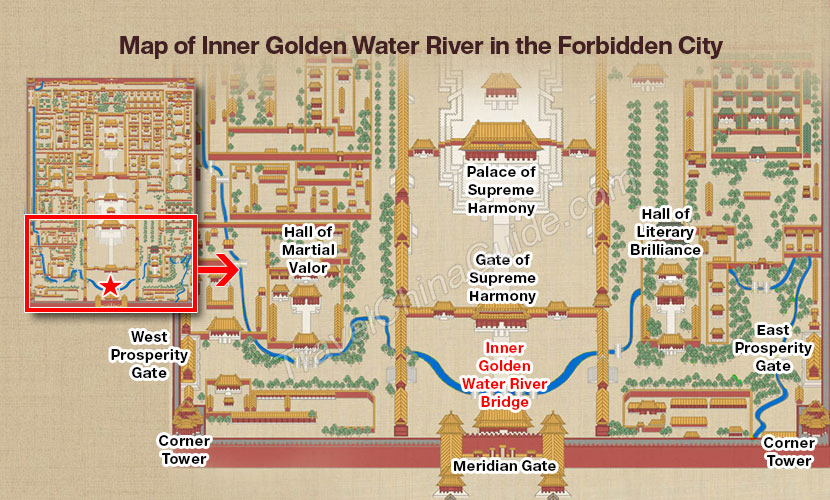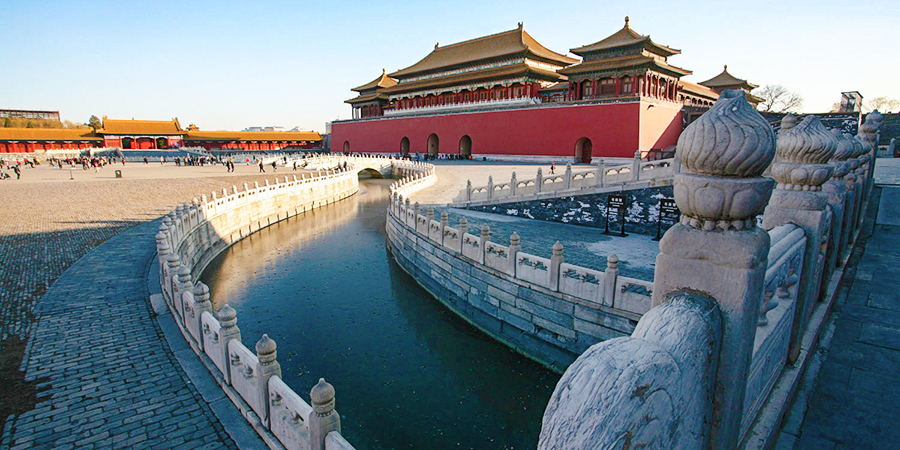Inner Golden Water River - A Giant Snake Hidden in Forbidden City
Facts of Inner Golden Water River
Source: Jade Spring Hill
Length: 2,100 meters (6,890 feet)
Width: 2 meters (6.6 feet) - 11.8 meters (38.7 feet)
Depth: 4 meters (13 feet)
Riverway: Flows in Forbidden City from northwest corner - West Prosperity Gate - Gate of Martial Valor - Gate of Supreme Harmony Square - Hall of Literary Glory - East Prosperity Gate - Flows out from southeast corner
 |
| Map of Inner Golden Water River |
Main Functions of the Inner Golden Water River: Fire Protection and Flood Control
The winding Inner Golden Water River plays an important role in the fire prevention and drainage of ancient buildings in the Forbidden City.
The Inner Golden Water River provided sufficient water to put out fires in the ancient buildings. The ancient buildings in the Forbidden City are mainly built of wood, and the internal and external eaves of the buildings are decorated with oil-based flammable materials. Once a fire breaks out, there must be timely and sufficient water to put out the fire. Although there are 72 wells in the Forbidden City, they cannot meet the water demand for putting out a fire. The water source is limited and the number of palace buildings in the Forbidden City is large. The water source of the Inner Golden Water River is inexhaustible. Furthermore, the Inner Golden Water River winds and flows close to the various palaces to facilitate timely fire fighting.
 |
The Inner Golden Water River is an important part of the drainage system of the Forbidden City. The flood season in Beijing is generally from June to mid-September. Although the rain increases dramatically in this period, there has never been a problem of water accumulation in the more than 9000 rooms of the Forbidden City. Even a rainstorm does not affect it, which demonstrates the benefits of an excellent drainage system. The drainage system of the Forbidden City includes three parts: the roof, the ground part and the underground part. The roof drainage is very fast and smooth. And the ground and underground drainage systems ingeniously crisscross and connect various palaces and courtyards. They discharge rainwater from the central axis to the east and west sides of the Forbidden City, and then to the Inner Golden Water River from the north to the south. Finally, rainwater is discharged and flows into the Moat and then into the Huihe River.
 |
Why is the River Called a ‘Snake’?
The answer lies in the zigzagging path of the riverway, which resembles a winding snake. Some sections of the riverbank wind like a snake. Other sections of the River are interesting because the riverbanks look straight, but the bottom of the river is paved into a curving shape. At the point where the Inner Golden Water River emerges from the Forbidden City, the river way turns and twists and shows several s-shaped curves. From a bird’s eye view, the river is exactly the shape of the head and neck of a snake.
Reasons to Design a River in a Snake Shape
One of the reasons to design the Inner Golden Water River in a snake shape is that the ancients believed that snakes are the household deity that can protect the house. People who designed the Forbidden City regarded it as a huge house that needed protection. In fact, for nearly 600 years, the giant snake has been protecting the Forbidden City. Several recorded fires in history were put out due to the sufficient and timely water supply of the Inner Golden Water River. In addition, the River is an important part of the Forbidden City’s architectural landscape and adds to the vitality and beauty of the buildings.